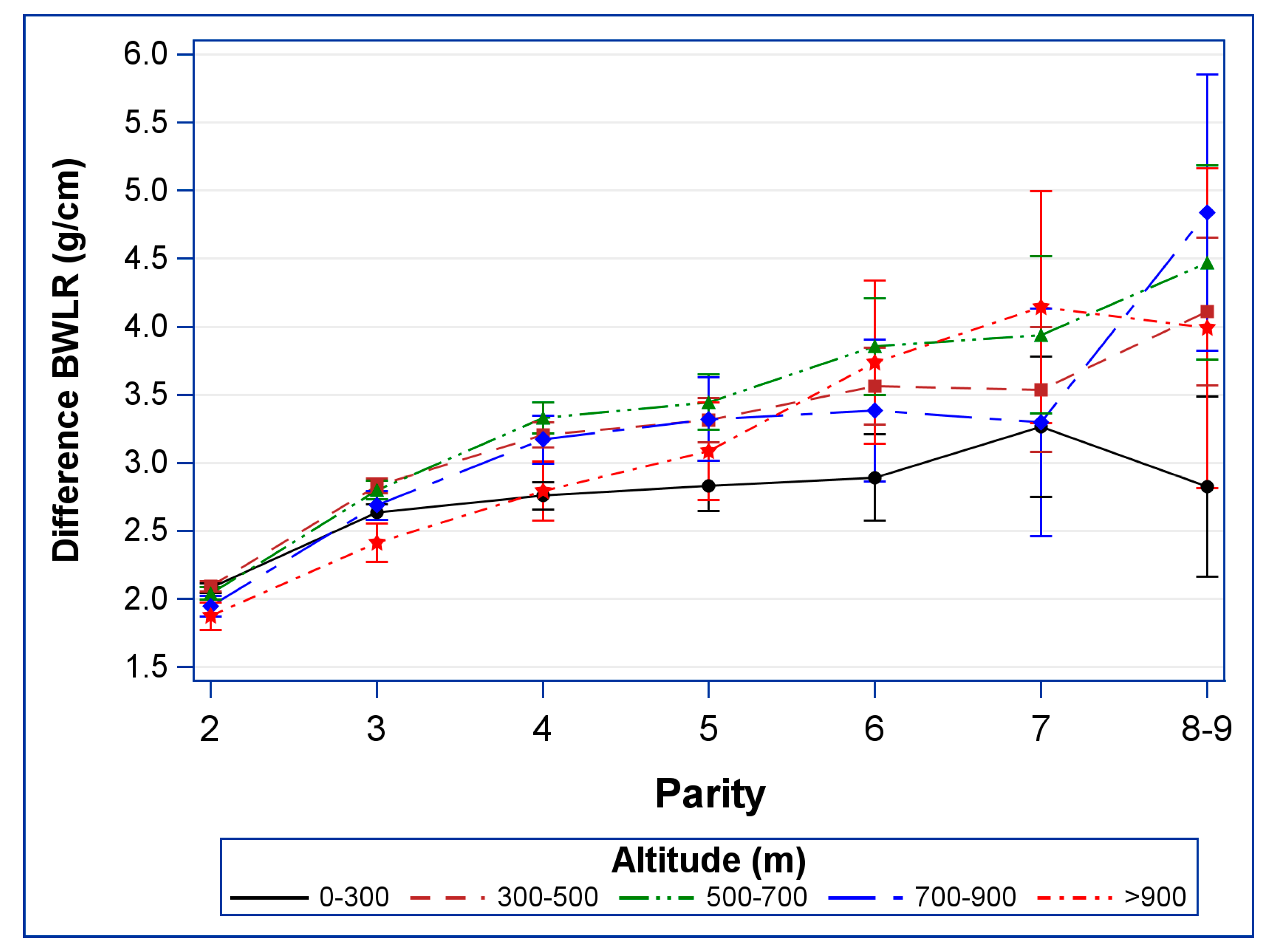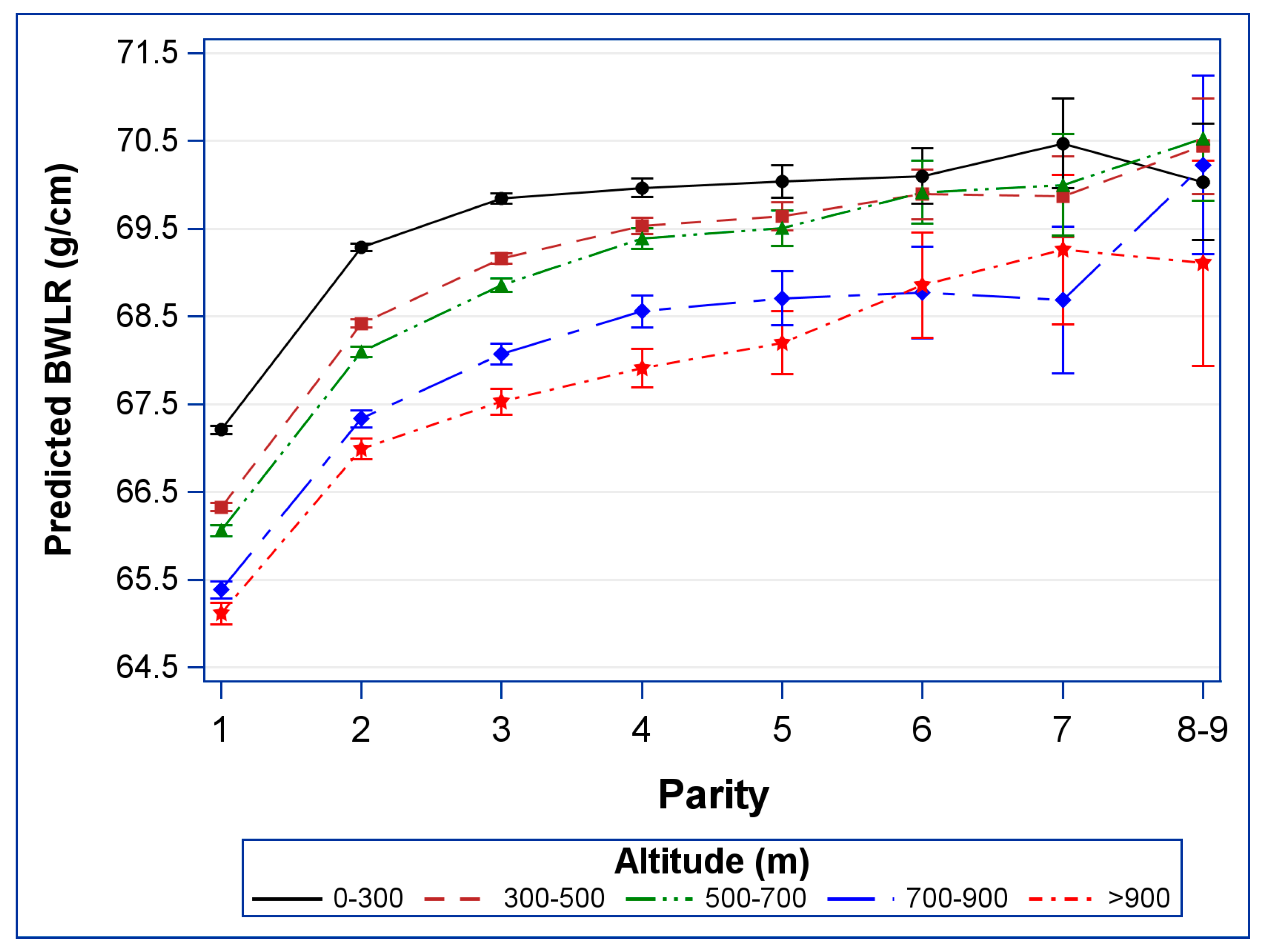Altitude Modifies the Effect of Parity on Birth Weight/Length Ratio: A Study Comprising 2,057,702 Newborns between 1984 and 2020 in Austria
Abstract
1. Introduction
2. Materials and Methods
Statistical Analysis
3. Results
4. Discussion
Supplementary Materials
Author Contributions
Funding
Institutional Review Board Statement
Informed Consent Statement
Data Availability Statement
Conflicts of Interest
References
- Francis, J.H.; Permezel, M.; Davey, M.A. Perinatal mortality by birthweight centile. Aust. N. Z. J. Obstet. Gynaecol. 2014, 54, 354–359. [Google Scholar] [PubMed]
- Prinz, N.; Putri, R.R.; Reinehr, T.; Danielsson, P.; Weghuber, D.; Norman, M.; Rochow, N.; Marcus, C.; Holl, R.W.; Hagman, E. The association between perinatal factors and cardiometabolic risk factors in children and adolescents with overweight or obesity: A retrospective two-cohort study. PLoS Med. 2023, 20, e1004165. [Google Scholar] [CrossRef] [PubMed]
- Richards, M. Birth weight and cognitive function in the British 1946 birth cohort: Longitudinal population based study. BMJ 2001, 322, 199–203. [Google Scholar] [PubMed]
- Nordman, H.; Jääskeläinen, J.; Voutilainen, R. Birth Size as a Determinant of Cardiometabolic Risk Factors in Children. Horm. Res. Paediatr. 2020, 93, 144–153. [Google Scholar] [CrossRef] [PubMed]
- Mu, M.; Ye, S.; Bai, M.-J.; Liu, G.-L.; Tong, Y.; Wang, S.-F.; Sheng, J. Birth Weight and Subsequent Risk of Asthma: A Systematic Review and Meta-Analysis. Heart Lung Circ. 2014, 23, 511–519. [Google Scholar] [CrossRef] [PubMed]
- Upadhyay, R.P.; Naik, G.; Choudhary, T.S.; Chowdhury, R.; Taneja, S.; Bhandari, N.; Martines, J.C.; Bahl, R.; Bhan, M.K. Cognitive and motor outcomes in children born low birth weight: A systematic review and meta-analysis of studies from South Asia. BMC Pediatr. 2019, 19, 35. [Google Scholar]
- Hassen, T.A.; Chojenta, C.; Egan, N.; Loxton, D. The association between birth weight and proxy-reported health-related quality of life among children aged 5–10 years old: A linked data analysis. BMC Pediatr. 2021, 21, 408. [Google Scholar] [CrossRef] [PubMed]
- Garces, A.; Perez, W.; Harrison, M.S.; Hwang, K.S.; Nolen, T.L.; Goldenberg, R.L.; Patel, A.B.; Hibberd, P.L.; Lokangaka, A.; Tshefu, A.; et al. Association of parity with birthweight and neonatal death in five sites: The Global Network’s Maternal Newborn Health Registry study. Reprod. Health 2020, 17, 182. [Google Scholar] [CrossRef]
- Spracklen, C.N.; Ryckman, K.K.; Harland, K.; Saftlas, A.F. Effects of smoking and preeclampsia on birth weight for gestational age. J. Matern. Fetal Neonatal Med. 2015, 28, 679–684. [Google Scholar] [CrossRef][Green Version]
- Khan, A.; Nasrullah, F.D.; Jaleel, R. Frequency and risk factors of low birth weight in term pregnancy. Pak. J. Med. Sci. 1969, 32, 138–142. [Google Scholar]
- Jensen, G.M.; Moore, L.G. The effect of high altitude and other risk factors on birthweight: Independent or interactive effects? Am. J. Public Health 1997, 87, 1003–1007. [Google Scholar] [PubMed]
- Klebermass-Schrehof, K.; Waldhoer, T.; Yang, L. The Effect of Altitude on Birthweight/Length Ratio: A Population-Based Study Over 36 Years in an Altitude Range from Sea Level to 1700 m. High Alt. Med. Biol. 2022, 23, 90–95. [Google Scholar] [CrossRef] [PubMed]
- Yang, L.; Helbich-Poschacher, V.; Cao, C.; Klebermass-Schrehof, K.; Waldhoer, T. Maternal altitude and risk of low birthweight: A systematic review and meta-analyses. Placenta 2020, 101, 124–131. [Google Scholar] [CrossRef] [PubMed]
- Ertl, R.; Waldhoer, T.; Yang, L. Moderate altitude impacts birth weight: 30 years retrospective sibling analyses using record linkage data. Pediatr. Res. 2019, 86, 403–407. [Google Scholar] [CrossRef] [PubMed]
- Colson, A.; Sonveaux, P.; Debiève, F.; Sferruzzi-Perri, A.N. Adaptations of the human placenta to hypoxia: Opportunities for interventions in fetal growth restriction. Hum. Reprod. Update 2021, 27, 531–569. [Google Scholar] [CrossRef] [PubMed]
- Moore, L.G.; Shriver, M.; Bemis, L.; Hickler, B.; Wilson, M.; Brutsaert, T.; Parra, E.; Vargas, E. Maternal Adaptation to High-altitude Pregnancy: An Experiment of Nature—A Review. Placenta 2004, 25, S60–S71. [Google Scholar] [PubMed]
- Williams, A.M.; Levine, B.D.; Stembridge, M. A change of heart: Mechanisms of cardiac adaptation to acute and chronic hypoxia. J. Physiol. 2022, 600, 4089–4104. [Google Scholar] [CrossRef] [PubMed]
- Krampl, E.; Lees, C.; Bland, J.M.; Espinoza Dorado, J.; Moscoso, G.; Campbell, S. Fetal biometry at 4300 m compared to sea level in Peru: Fetal biometry at high altitude. Ultrasound Obstet. Gynecol. 2000, 16, 9–18. [Google Scholar] [CrossRef]
- Murray, A.J. Oxygen delivery and fetal-placental growth: Beyond a question of supply and demand? Placenta 2012, 33, e16–e22. [Google Scholar] [CrossRef]
- Shah, P.S. Parity and low birth weight and preterm birth: A systematic review and meta-analyses. Acta Obstet. Gynecol. Scand. 2010, 89, 862–875. [Google Scholar] [CrossRef]
- Hinkle, S.N.; Albert, P.S.; Mendola, P.; Sjaarda, L.A.; Yeung, E.; Boghossian, N.S.; Laughon, S.K. The Association between Parity and Birthweight in a Longitudinal Consecutive Pregnancy Cohort: Parity and birthweight in consecutive pregnancies. Paediatr. Perinat. Epidemiol. 2014, 28, 106–115. [Google Scholar] [CrossRef] [PubMed]
- Sha, T.; Gao, X.; Chen, C.; Li, L.; He, Q.; Wu, X.; Cheng, G.; Tian, Q.; Yang, F.; Yan, Y. Associations of Pre-Pregnancy BMI, Gestational Weight Gain and Maternal Parity with the Trajectory of Weight in Early Childhood: A Prospective Cohort Study. Int. J. Environ. Res. Public Health 2019, 16, 1110. [Google Scholar] [CrossRef] [PubMed]
- Khalid, M.E.M.; Ahmed, H.S.; Osman, O.M.; Al Hashem, F.H. The Relationship of Birth Weight, Body Shape and Body Composition at Birth to Altitude in Saudi Arabia. Int. J. Morphol. 2016, 34, 1109–1116. [Google Scholar] [CrossRef]
- Zimna, A.; Kurpisz, M. Hypoxia-Inducible Factor-1 in Physiological and Pathophysiological Angiogenesis: Applications and Therapies. BioMed Res. Int. 2015, 2015, 549412. [Google Scholar] [CrossRef] [PubMed]
- Befani, C.; Liakos, P. The role of hypoxia-inducible factor-2 alpha in angiogenesis. J. Cell. Physiol. 2018, 233, 9087–9098. [Google Scholar] [CrossRef] [PubMed]
- Pringle, K.G.; Kind, K.L.; Sferruzzi-Perri, A.N.; Thompson, J.G.; Roberts, C.T. Beyond oxygen: Complex regulation and activity of hypoxia inducible factors in pregnancy. Hum. Reprod. Update 2010, 16, 415–431. [Google Scholar] [CrossRef] [PubMed]
- Bhandari, S.; Dolma, P.; Mukerji, M.; Prasher, B.; Montgomery, H.; Kular, D.; Jain, V.; Dadhwal, V.; Williams, D.J.; Bhattacharyaa, A.; et al. Population history and genome wide association studies of birth weight in a native high altitude Ladakhi population. PLoS ONE 2022, 17, e0269671. [Google Scholar] [CrossRef]
- Wilcox, M.A.; Chang, A.M.Z.; Johnson, I.R. The effects of parity on birthweight using successive pregnancies. Acta Obstet. Et Gynecol. Scand. 1996, 75, 459–463. [Google Scholar] [CrossRef]
- Bohn, C.; Vogel, M.; Poulain, T.; Spielau, U.; Hilbert, C.; Kiess, W.; Körner, A. Birth weight increases with birth order despite decreasing maternal pregnancy weight gain. Acta Paediatr. 2021, 110, 1218–1224. [Google Scholar] [CrossRef]
- Hermanussen, M.; Scheffler, C. Secular trends in gestational weight gain and parity on birth weight: An editorial. Acta Paediatr. 2021, 110, 1094–1096. [Google Scholar] [CrossRef]
- Gassner, U.K. Ueber die Veränderungen des Körpergewichtes bei Schwangeren, Gebärenden und Wöchnerinnen; Dr. v. A. Th. Engelhardt: Louisville, KY, USA, 1861; Volume 19. [Google Scholar]
- Benacerraf, B.R.; Shipp, T.D.; Lyons, J.G.; Bromley, B. Width of the Normal Uterine Cavity in Premenopausal Women and Effect of Parity. Obstet. Gynecol. 2010, 116, 305–310. [Google Scholar] [CrossRef] [PubMed]
- Flatley, C.; Sole-Navais, P.; Vaudel, M.; Helgeland, Ø.; Modzelewska, D.; Johansson, S.; Jacobsson, B.; Njølstad, P. Placental weight centiles adjusted for age, parity and fetal sex. Placenta 2022, 117, 87–94. [Google Scholar] [CrossRef] [PubMed]
- Goldman-Wohl, D.; Gamliel, M.; Mandelboim, O.; Yagel, S. Learning from experience: Cellular and molecular bases for improved outcome in subsequent pregnancies. Am. J. Obstet. Gynecol. 2019, 221, 183–193. [Google Scholar] [CrossRef] [PubMed]
- Khong, T.Y.; Adema, E.D.; Erwich, J.J.H.M. On an Anatomical Basis for the Increase in Birth Weight in Second and Subsequent Born Children. Placenta 2003, 24, 348–353. [Google Scholar] [CrossRef]
- Gamliel, M.; Goldman-Wohl, D.; Isaacson, B.; Gur, C.; Stein, N.; Yamin, R.; Berger, M.; Grunewald, M.; Keshet, E.; Rais, Y.; et al. Trained Memory of Human Uterine NK Cells Enhances Their Function in Subsequent Pregnancies. Immunity 2018, 48, 951–962.e5. [Google Scholar] [CrossRef] [PubMed]
- Knöfler, M.; Haider, S.; Saleh, L.; Pollheimer, J.; Gamage, T.K.J.B.; James, J. Human placenta and trophoblast development: Key molecular mechanisms and model systems. Cell. Mol. Life Sci. 2019, 76, 3479–3496. [Google Scholar] [CrossRef] [PubMed]
- McAuliffe, F.; Kametas, N.; Krampl, E.; Ernsting, J.; Nicolaides, K. Blood gases in pregnancy at sea level and at high altitude. BJOG Int. J. Obstet. Gynaecol. 2001, 108, 980–985. [Google Scholar] [CrossRef] [PubMed]
- Palmer, S.K.; Moore, L.G.; Young, D.A.; Cregger, B.; Berman, J.C.; Zamudio, S. Altered blood pressure course during normal pregnancy and increased preeclampsia at high altitude (3100 m) in Colorado. Am. J. Obstet. Gynecol. 1999, 180, 1161–1168. [Google Scholar] [CrossRef]
- Burtscher, M. Effects of Living at Higher Altitudes on Mortality: A Narrative Review. Aging Dis. 2014, 5, 274–280. [Google Scholar] [CrossRef]
- Baban, A.; Olivini, N.; Cantarutti, N.; Calì, F.; Vitello, C.; Valentini, D.; Adorisio, R.; Calcagni, G.; Alesi, V.; Di Mambro, C.; et al. Differences in morbidity and mortality in Down syndrome are related to the type of congenital heart defect. Am. J. Med. Genet. 2020, 182, 1342–1350. [Google Scholar] [CrossRef]
- Bernabe-Ortiz, A.; Carrillo-Larco, R.M. Urbanization, Altitude and Cardiovascular Risk. Glob. Heart 2022, 17, 42. [Google Scholar] [CrossRef]


Disclaimer/Publisher’s Note: The statements, opinions and data contained in all publications are solely those of the individual author(s) and contributor(s) and not of MDPI and/or the editor(s). MDPI and/or the editor(s) disclaim responsibility for any injury to people or property resulting from any ideas, methods, instructions or products referred to in the content. |
© 2023 by the authors. Licensee MDPI, Basel, Switzerland. This article is an open access article distributed under the terms and conditions of the Creative Commons Attribution (CC BY) license (https://creativecommons.org/licenses/by/4.0/).
Share and Cite
Karner, E.; Muin, D.A.; Klebermass-Schrehof, K.; Waldhoer, T.; Yang, L. Altitude Modifies the Effect of Parity on Birth Weight/Length Ratio: A Study Comprising 2,057,702 Newborns between 1984 and 2020 in Austria. Life 2023, 13, 1718. https://doi.org/10.3390/life13081718
Karner E, Muin DA, Klebermass-Schrehof K, Waldhoer T, Yang L. Altitude Modifies the Effect of Parity on Birth Weight/Length Ratio: A Study Comprising 2,057,702 Newborns between 1984 and 2020 in Austria. Life. 2023; 13(8):1718. https://doi.org/10.3390/life13081718
Chicago/Turabian StyleKarner, Eva, Dana A. Muin, Katrin Klebermass-Schrehof, Thomas Waldhoer, and Lin Yang. 2023. "Altitude Modifies the Effect of Parity on Birth Weight/Length Ratio: A Study Comprising 2,057,702 Newborns between 1984 and 2020 in Austria" Life 13, no. 8: 1718. https://doi.org/10.3390/life13081718
APA StyleKarner, E., Muin, D. A., Klebermass-Schrehof, K., Waldhoer, T., & Yang, L. (2023). Altitude Modifies the Effect of Parity on Birth Weight/Length Ratio: A Study Comprising 2,057,702 Newborns between 1984 and 2020 in Austria. Life, 13(8), 1718. https://doi.org/10.3390/life13081718






